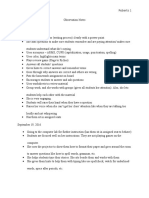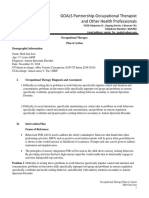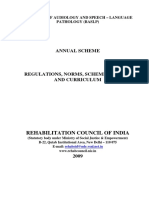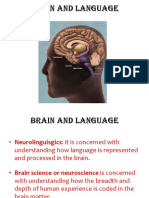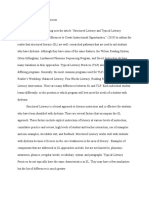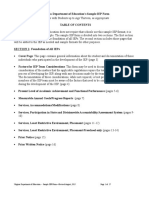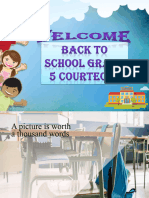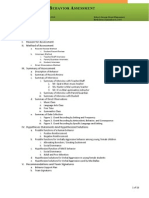Hewett-K-Sped 875-M7co-Teaching LP
Hewett-K-Sped 875-M7co-Teaching LP
Uploaded by
api-386067949Copyright:
Available Formats
Hewett-K-Sped 875-M7co-Teaching LP
Hewett-K-Sped 875-M7co-Teaching LP
Uploaded by
api-386067949Original Title
Copyright
Available Formats
Share this document
Did you find this document useful?
Is this content inappropriate?
Copyright:
Available Formats
Hewett-K-Sped 875-M7co-Teaching LP
Hewett-K-Sped 875-M7co-Teaching LP
Uploaded by
api-386067949Copyright:
Available Formats
University of Kansas Dept.
of Special Education
SPED 875: Co-Teaching Assignment
SPED 875: Advanced Practicum with Children and Youth with Disabilities: High
Incidence/Adaptive
This assignment fulfills KSDE Standard 5: The special demonstrates effective communication
skills to enhance collaboration and consultation among school professionals, to improve learner
outcomes while planning for and implementing effective instruction and services; to implement
the IEP, deliver instruction, and evaluate IEP implementation; and, to plan for and implement
effective transition services.
Resource B: Co-Teaching Daily Lesson Plan Format
From A Guide to Co-Teaching (Villa, Thousand & Nevin, 2013, p.202-203)
Date: 3/29/23
Co-Teachers (Names):
Katherine Hewett (special education teacher)
Lindsey Boomershine (paraprofessional)
Content Area(s)
Social-Emotional Learning
Lesson Objectives:
SWBAT identify different emotions in given scenarios.
SWBAT describe their responsibility in peer interactions at recess.
Language Objectives:
SWBAT verbally identify their emotions with appropriate feelings words (happy, sad,
angry, etc.).
SWBAT verbally describe their responsibility in peer interactions at recess.
Content Standards Addressed:
IN 5.4.1. Demonstrate effective verbal and nonverbal communication skills to enhance
health.
IN 5.4.3. Demonstrate nonviolent strategies to manage or resolve conflict.
Underline the Co-Teaching Model(s) Used:
Supportive Parallel Complementary Team
Fall Semester 2020
Martha D. Elford, Ph.D.
University of Kansas Dept. of Special Education
SPED 875: Co-Teaching Assignment
What is the room arrangement? Will other spaces outside of the classroom be used? (Draw a
picture of the room arrangement.)
The lesson/conversation will take place at a table in front of a whiteboard in the special
educators’ resource classroom.
What materials do the co-teachers and/or students need?
Whiteboard and projector
Feelings GIF collage
iPad and tripod (to film conversation)
What specific supports, aids, or services do select students need? (See Resource A for
suggestion)
Planned seating
Teach to the student’s learning style/strength intelligences
Verbal and Visual presentation of content
Focus on social process rather than the end product
Teach social communication skills
Use of Conversation social interaction support
Part-time daily support
One-on-one assistance (transitions after recess)
Lesson Plan
Lesson Plan for Instruction
Introduction # of minutes: 1-2
(Anticipatory set,
thinking device, Explain the purpose of the conversation (check-in on
social and emotional progress that has been made with
advance organizer, the paraprofessional during conversations after recess
lesson “hook”) transitions)
Lesson activities #
(Content, methods, # of minutes: 5
strategies, Starting with the student, take turns identifying current
procedures, feelings based on GIFs in feelings collage
formative Discuss with student social progress at recess
assessment) o Fist-to-five rating scale to answer questions
o Teacher and para take turns asking follow-up
questions to allow more opportunities for student
Fall Semester 2020
Martha D. Elford, Ph.D.
University of Kansas Dept. of Special Education
SPED 875: Co-Teaching Assignment
to elaborate on answers
Closure # of minutes: 1-2
Wrap up conversation
Discuss next steps for student to continue progress
Fall Semester 2020
Martha D. Elford, Ph.D.
4
University of Kansas Dept. of Special Education
SPED 875: Co-Teaching Assignment
What does each co-teacher do before, during, and after the lesson?
Co-Teacher Katherine Hewett Lindsey Boomershine
Name
What are the Set up the classroom (turn Pick up the student from recess
specific tasks that on whiteboard and display and bring them to the classroom
I do BEFORE the collage)
lesson? Get iPad and tripod ready
to take video of lesson
What are the Explain to the student the Restate other participants’
specific tasks that purpose of the answers to demonstrate good
I do During the conversation conversation skills
lesson? Ask leading questions to Ask follow-up questions to
facilitate conversation further encourage student
participation in the conversation
What are the Clean up the classroom Return student to general
specific tasks that (turn off whiteboard, stop education classroom
I do AFTER the video recording, take down
lesson? iPad from tripod)
Where, when, and how do co-teachers debrief and evaluate the outcomes of the lesson?
The teachers will discuss and debrief outcomes in the resource room immediately after the lesson via
verbal discussion.
Fall Semester 2020
Martha D. Elford, Ph.D.
5
University of Kansas Dept. of Special Education
SPED 875: Co-Teaching Assignment
SPED 875: Advanced Practicum with Children and Youth with Disabilities: High
Incidence/Adaptive
This assignment fulfills KSDE Standard 5: The special demonstrates effective communication skills to enhance
collaboration and consultation among school professionals, to improve learner outcomes while planning for and
implementing effective instruction and services; to implement the IEP, deliver instruction, and evaluate IEP
implementation; and, to plan for and implement effective transition services.
Resource A: Checklist of Sample Supplemental Supports, Aids and Services
From A Guide to Co-Teaching (Villa, Thousand & Nevin, 2013, pp.198-201)
Directions: When considering the need for personalized supports, aids or services for a student, use this checklist
to help identify which supports will be the least intrusive, only as special as necessary, and the most natural to the
context of the classroom.
Environmental
___Preferential seating
_X_Planned seating
___Bus ___Classroom ___Lunchroom ___Auditorium ___Other _____
___Alter physical room arrangement (Specify: ___________________________)
___Use study carrels or quiet areas
___Define area concretely (e.g., carpet squares, tape on floor, rug area)
___Reduce/minimize distractions
___Visual ___Spatial ___Auditory ___Movement
___Teach positive rules for use of space
Pacing of Instruction
___Extend time requirements
___Vary activity often
___Allow breaks
___Omit assignments requiring copying in timed situations
___Send additional copy of the text home for summer preview
___Provide home set of materials for preview or review
Presentation of Subject Matter
_X_Teach to the student’s learning style/strength intelligences
_X_Verbal/Linguistic ___Logical/Mathematical _X_Visual/Spatial ___Naturalist
___Bodily/Kinesthetic ___Musical ___Interpersonal ___Intrapersonal
___Use active, experiential learning
Fall Semester 2020
Martha D. Elford, Ph.D.
6
University of Kansas Dept. of Special Education
SPED 875: Co-Teaching Assignment
___Use specialized curriculum
___Record class lectures and discussions to replay later
___Use American Sign Language and/or total communication
___Provide prewritten notes, an outline, or an organizer (e.g., mind map)
___Provide copy of classmate’s notes (e.g., use NCR paper, photocopy)
___Use functional and meaningful application of academic skills
___Present demonstrations and models
___Use manipulatives and real objects in mathematics
___Highlight critical information or main ideas
___Preteach vocabulary
___Make and use vocabulary files or provide vocabulary lists
___Reduce the language level of the reading assignment
___Use facilitated communication
___Use visual organizers/sequences
___Use paired reading/writing
___Reduce seat time in class or activities
___Use diaries or learning logs
___Reword/rephrase instructions and questions
___Preview and review major concepts in primary language
Materials
___Limit amount of material on a page
___Record texts and other class materials
___Use study guides and advanced organizers
___Use supplementary materials
___Provide note-taking assistance
___Copy class notes
___Scan tests and class notes into computer
___Use large print
___Use braille material
___Use communication book or board
___Provide assistive technology and software (e.g., Intelli-Talk)
Specialized Equipment or Procedure
___Wheelchair ___Walker
___Standing board ___Positioning
___Computer ___Computer software
___Electronic typewriter ___Video/DVD
___Modified keyboard ___Voice synthesizer
___Switches ___Augmentative communication device
___Catheterization ___Suctioning
___Braces ___Restroom equipment
Fall Semester 2020
Martha D. Elford, Ph.D.
7
University of Kansas Dept. of Special Education
SPED 875: Co-Teaching Assignment
___Customized mealtime utensils, plates, cups, and other materials
Assignment Modification
___Give directions in small, distinct steps (written/picture/verbal)
___Use written backup for oral directions
___Use pictures as supplement to oral directions
___Lower difficulty level ___Raise difficulty level
___Shorten assignments ___Reduce paper-and-pencil tasks
___Read or record directions to the student(s)
___Give extra cues or prompts
___Allow student to record or type assignments
___Adapt worksheets and packets
___Use compensatory procedures by providing alternate assignments when demands of class conflict with
student capabilities
___Ignore spelling errors/sloppy work ___Ignore penmanship
___Develop alternative rubrics
Self-Management/Follow-Through
___Provide pictorial or written daily or weekly schedule
___Provide student calendars
___Check often for understanding/review
___Request parent reinforcement
___Have student repeat directions
___Teach study skills
___Use binders to organize material
___Design/write/use long-term assignment timelines
___Review and practice in real situations
___Plan for generalization by teaching skill in several environments
Testing Adaptations
___Provide oral instructions and/or read test questions
___Use pictorial instructions/questions
___Read test to student
___Preview language of test questions
___Ask questions that have applications in real setting
___Administer test individually
___Use short answer ___Use multiple choice ___Shorten length
___Extend time frame ___Use open-note/open-book tests
___Modify format to reduce visual complexity or confusion
Social Interaction Support
___Use natural peer supports and multiple, rotating peers
Fall Semester 2020
Martha D. Elford, Ph.D.
8
University of Kansas Dept. of Special Education
SPED 875: Co-Teaching Assignment
___Use peer advocacy
___Use cooperative group learning
___Institute peer tutoring
___Structure opportunities for social interaction (e.g., Circle of Friends)
_X_Focus on social process rather than the end product
___Structure shared experiences in school and extracurricular activities
___Teach friendship, sharing, and negotiation skills to classmates
_X_Teach social communication skills
___Greetings _X_Conversation ___Turn Taking ___Sharing
___Negotiation ___Other ___________________
Level of Staff Support (Consider after considering previous categories)
___Consultation
___Stop-in support (one to three times per week)
_X_Part-time daily support
___Team teaching (parallel, supportive, complementary, or co-teaching)
___Daily in-class staff support
___Total staff support (staff are in close proximity)
_X_One-on-one assistance
___Specialized personnel support (If indicated, identify time needed)
Support Time Needed
___Instructional support assistant
___Health care assistant
___Behavior assistant
___Signing assistant
___Nursing
___Occupational therapy
___Physical therapy
___Speech and language therapist
___Augmentative communication specialist
___Transportation
___Counseling
___Adaptive physical education
___Transition planning
___Orientation/mobility
___Career counseling
Fall Semester 2020
Martha D. Elford, Ph.D.
You might also like
- Case Study 1 Activity 1 6Document45 pagesCase Study 1 Activity 1 6Rosalie Catalan Eslabra75% (4)
- The Effects of Syllable Instruction On Phonemic Awareness in PreschoolersDocument11 pagesThe Effects of Syllable Instruction On Phonemic Awareness in Preschoolerslifiana khofifahNo ratings yet
- SP Patienthandout AphasicpatientDocument1 pageSP Patienthandout Aphasicpatientapi-11473948750% (2)
- Natalie Brickner-Slp ResumeDocument1 pageNatalie Brickner-Slp Resumeapi-238387904No ratings yet
- Sped413 A I Technology Resource Guide OrganizerDocument8 pagesSped413 A I Technology Resource Guide Organizerapi-384692878No ratings yet
- Diamond A Sped730 m8 Revised Coteaching Lesson PlansDocument6 pagesDiamond A Sped730 m8 Revised Coteaching Lesson Plansapi-361519387No ratings yet
- 5E Lesson Plan Template: Teacher Cedreia BryantDocument8 pages5E Lesson Plan Template: Teacher Cedreia Bryantapi-541530322No ratings yet
- Hewett K Sped730 m8 Interview PaperDocument10 pagesHewett K Sped730 m8 Interview Paperapi-386067949No ratings yet
- Szumlanski D Sped741 m6 Scavenger HuntDocument1 pageSzumlanski D Sped741 m6 Scavenger Huntapi-296328009No ratings yet
- Observation NotesDocument6 pagesObservation Notesapi-328729680No ratings yet
- Iep Overview EssayDocument4 pagesIep Overview Essayapi-530012202No ratings yet
- 5E Lesson Plan Template: Teacher Cedreia BryantDocument8 pages5E Lesson Plan Template: Teacher Cedreia Bryantapi-541530322No ratings yet
- PE3011 English Language Studies and Teaching 1 Phonetics Lecture 7Document13 pagesPE3011 English Language Studies and Teaching 1 Phonetics Lecture 7twy113No ratings yet
- How I Use Electropalatography (1) : Moving Forward With EPGDocument5 pagesHow I Use Electropalatography (1) : Moving Forward With EPGSpeech & Language Therapy in PracticeNo ratings yet
- IepcasestudyDocument13 pagesIepcasestudyapi-285055482No ratings yet
- Hall2019 - Reading Instruction For English Learners With Learning DisabilitiesDocument45 pagesHall2019 - Reading Instruction For English Learners With Learning DisabilitiesErick SolisNo ratings yet
- Speech or Language ImpairmentDocument31 pagesSpeech or Language ImpairmentPrecious AmethystNo ratings yet
- Megan Gregory 856 rp2 Original Assignment With FeedbackDocument14 pagesMegan Gregory 856 rp2 Original Assignment With Feedbackapi-271896767No ratings yet
- M8 Assignment: Running Project Part 2Document8 pagesM8 Assignment: Running Project Part 2api-386067949No ratings yet
- Case Study: Final Plan and Presentation ReflectionDocument3 pagesCase Study: Final Plan and Presentation Reflectionapi-516283582No ratings yet
- Sped 741 - Case StudyDocument11 pagesSped 741 - Case Studyapi-611338134No ratings yet
- Iep PaperDocument3 pagesIep Paperapi-283801172No ratings yet
- Outstanding Achieved In-Progress Beginner Score: Oral Presentation Rubric (3 To6 Grade)Document2 pagesOutstanding Achieved In-Progress Beginner Score: Oral Presentation Rubric (3 To6 Grade)Raul Felix Neyra PrietoNo ratings yet
- 01 Pediatric Clinics - February2009Document291 pages01 Pediatric Clinics - February2009Tessa CruzNo ratings yet
- rp1 Szumlanski DDocument8 pagesrp1 Szumlanski Dapi-296328009No ratings yet
- Kaufman J Sped741 Originalandfeedback Artifact9 CommoncoreDocument2 pagesKaufman J Sped741 Originalandfeedback Artifact9 Commoncoreapi-334255828No ratings yet
- Ellison C ct807 m8 MediaanalysisprojectDocument9 pagesEllison C ct807 m8 Mediaanalysisprojectapi-352916175No ratings yet
- Carmen Boyer 743 Fabi With Feedback 1Document19 pagesCarmen Boyer 743 Fabi With Feedback 1api-548359274No ratings yet
- GOALS Partnership-Occupational Therapist and Other Health ProfessionalsDocument5 pagesGOALS Partnership-Occupational Therapist and Other Health ProfessionalsarvinNo ratings yet
- Summary From Student Feedback and Mentor Teachers Comments On ItDocument1 pageSummary From Student Feedback and Mentor Teachers Comments On Itapi-483734281No ratings yet
- M4 Assignment: Running Project Part 1Document12 pagesM4 Assignment: Running Project Part 1api-386067949No ratings yet
- Beth-Montick-Sped841-Final Course Project Assignment - ReflectionDocument2 pagesBeth-Montick-Sped841-Final Course Project Assignment - Reflectionapi-324599447No ratings yet
- Beth Montick-Sped743-Fabi-ChecklistsDocument10 pagesBeth Montick-Sped743-Fabi-Checklistsapi-324599447No ratings yet
- CfyresumeDocument2 pagesCfyresumeapi-401014427No ratings yet
- ASPECTS OF CONNECTED SPEECH AssimilationDocument7 pagesASPECTS OF CONNECTED SPEECH AssimilationTahar MeklaNo ratings yet
- Dibels Assessment Paper FinalDocument15 pagesDibels Assessment Paper Finalapi-473349564No ratings yet
- Szumlanski D Sped741 m4 VocabularyDocument6 pagesSzumlanski D Sped741 m4 Vocabularyapi-296328009100% (1)
- Learnerprofile ComplexstudentDocument2 pagesLearnerprofile Complexstudentapi-287485113No ratings yet
- Running Head: Week Seven Case Studies 1Document3 pagesRunning Head: Week Seven Case Studies 1api-281775629No ratings yet
- Baslp Annual09Document84 pagesBaslp Annual09Ðèépü BäghêlNo ratings yet
- Brain and LanguageDocument34 pagesBrain and LanguageJéssica TostesNo ratings yet
- ApproachesDocument3 pagesApproachesDaisy xoNo ratings yet
- Kaufman J Sped741 Reflection-Artifact9 CommoncoreassignmentDocument2 pagesKaufman J Sped741 Reflection-Artifact9 Commoncoreassignmentapi-334255828No ratings yet
- Literacy AssessmentDocument10 pagesLiteracy Assessmentapi-457624055No ratings yet
- Carmen Boyer 741 RevisionsDocument8 pagesCarmen Boyer 741 Revisionsapi-548359274No ratings yet
- Unit 5 Mastery SnyderDocument7 pagesUnit 5 Mastery Snyderapi-644278221No ratings yet
- Sean Laughlin 741 Original Assignment With FeedbackDocument3 pagesSean Laughlin 741 Original Assignment With Feedbackapi-516283582No ratings yet
- Melodic Intonation Therapy and Aphasia Another Variation On A Theme PDFDocument13 pagesMelodic Intonation Therapy and Aphasia Another Variation On A Theme PDFCat TwentyTwoNo ratings yet
- Literacy Portfolio Jamie IsnorDocument17 pagesLiteracy Portfolio Jamie Isnorapi-511035771No ratings yet
- Student Assessment Project Final FinishedDocument15 pagesStudent Assessment Project Final Finishedapi-301858064No ratings yet
- Literacy Case Study On Maria S. TuttleDocument12 pagesLiteracy Case Study On Maria S. TuttleSteffani Crunk-TuttleNo ratings yet
- Module 3 - Article Review - Structured Literacy and Typical Literacy PracticesDocument3 pagesModule 3 - Article Review - Structured Literacy and Typical Literacy Practicesapi-530797247No ratings yet
- Case Study ReportDocument4 pagesCase Study Reportapi-280225301No ratings yet
- Case Study FinalDocument12 pagesCase Study Finalapi-206158968No ratings yet
- 2014mshahandouts StoeckelDocument37 pages2014mshahandouts StoeckelAna Vogeley100% (1)
- Iep ProjectDocument16 pagesIep Projectapi-494142720No ratings yet
- Case Study 741Document15 pagesCase Study 741api-88644317No ratings yet
- AssessmentstudyDocument5 pagesAssessmentstudyapi-379905868No ratings yet
- Speech Language ImpairmentsDocument34 pagesSpeech Language Impairmentskavya kumar kNo ratings yet
- Jennings Informal Reading AssessmentDocument53 pagesJennings Informal Reading AssessmentJoy Ledesma Fabros Domingo100% (2)
- Descriptive Text Presentation & D I ConceptDocument40 pagesDescriptive Text Presentation & D I ConceptFAUZANNo ratings yet
- Ku Sped 875 Alsa CVC Groups Data 1Document13 pagesKu Sped 875 Alsa CVC Groups Data 1api-386067949No ratings yet
- Ms Self Determination DocsDocument8 pagesMs Self Determination Docsapi-386067949No ratings yet
- Hewett K m4 Self Determination LPDocument1 pageHewett K m4 Self Determination LPapi-386067949No ratings yet
- "Basketball Addition": Artifact 3.2Document7 pages"Basketball Addition": Artifact 3.2api-386067949No ratings yet
- Hewett-K-M2-Assessment-Checklist Ms 2Document12 pagesHewett-K-M2-Assessment-Checklist Ms 2api-386067949No ratings yet
- "Standing Jumps" Data: Artifact 2.2Document9 pages"Standing Jumps" Data: Artifact 2.2api-386067949No ratings yet
- Katherine HewettDocument2 pagesKatherine Hewettapi-386067949No ratings yet
- Learning Styles: Artifact 1.2Document7 pagesLearning Styles: Artifact 1.2api-386067949No ratings yet
- Graphic Organizers: Artifact 4.1Document7 pagesGraphic Organizers: Artifact 4.1api-386067949No ratings yet
- AutobiographyDocument2 pagesAutobiographyapi-386067949No ratings yet
- Listening Exercise DAILY ACTIVITYDocument10 pagesListening Exercise DAILY ACTIVITYhuongquynhNo ratings yet
- SHS Blended CLASS SCHEDULEDocument5 pagesSHS Blended CLASS SCHEDULEMel MagsayoNo ratings yet
- Classroom Management PlanDocument5 pagesClassroom Management Planapi-308896998No ratings yet
- Teacher's ProgramDocument32 pagesTeacher's Programnidalyn jumawanNo ratings yet
- Differentiated Lesson PlanDocument9 pagesDifferentiated Lesson Planapi-501103450No ratings yet
- BM Tier 1Document11 pagesBM Tier 1api-249598233No ratings yet
- School Playground: Its Impact On Children's Learning and DevelopmentDocument3 pagesSchool Playground: Its Impact On Children's Learning and DevelopmentAnees QaziNo ratings yet
- PsychosocialDocument20 pagesPsychosocialStephanie LegartoNo ratings yet
- Student Teaching Daily Journal 2021-2022Document24 pagesStudent Teaching Daily Journal 2021-2022api-594480965No ratings yet
- Behavior Plan Template 01Document4 pagesBehavior Plan Template 01Sandra AustinNo ratings yet
- Week 6 KDocument20 pagesWeek 6 KGEMEMAH RUTH RONDAELNo ratings yet
- SchoolassessmentDocument10 pagesSchoolassessmentapi-283010563No ratings yet
- Observation Lenses 1-4Document4 pagesObservation Lenses 1-4api-489871389No ratings yet
- HCC Mobile Phone & Devices PolicyDocument3 pagesHCC Mobile Phone & Devices PolicyyuveerdawarNo ratings yet
- 6498 Field NotesDocument25 pages6498 Field NotesKomal Khan50% (2)
- Dissertation Examples Physical EducationDocument10 pagesDissertation Examples Physical EducationBestPaperWritersUK100% (1)
- Animal Farm Activities 1Document3 pagesAnimal Farm Activities 1Arivett ViloriaNo ratings yet
- Functional Behavioral Assessment Doc CMDDocument16 pagesFunctional Behavioral Assessment Doc CMDapi-197393144No ratings yet
- Class Program 2022-2023Document3 pagesClass Program 2022-2023Jeffrey VillangcaNo ratings yet
- Student Case Study Presentation Edi310Document10 pagesStudent Case Study Presentation Edi310api-639086780No ratings yet
- Abcs of Second GradeDocument2 pagesAbcs of Second Gradeapi-258140442No ratings yet
- Homework Finland SchoolsDocument4 pagesHomework Finland Schoolsg3nwncp4100% (1)
- Argumentative Research Paper-How Recess Benefits Children and TeachersDocument10 pagesArgumentative Research Paper-How Recess Benefits Children and TeachersJoe MbungaNo ratings yet
- CDC FullDocument129 pagesCDC FullEd CeeNo ratings yet
- ISAGANI B. ABRIL Final Classroom ProgramDocument2 pagesISAGANI B. ABRIL Final Classroom ProgramISAGANINo ratings yet
- CLASS-PROGRAM - Kinder - Grade1 - Grade4, GRADE 2 GRADE 3Document5 pagesCLASS-PROGRAM - Kinder - Grade1 - Grade4, GRADE 2 GRADE 3Mia LouiseNo ratings yet
- Sub BinderDocument2 pagesSub Binderapi-253093268No ratings yet
- Parents Night PacketDocument17 pagesParents Night Packetapi-325351225100% (1)
- How Technology Has Changed EducationDocument2 pagesHow Technology Has Changed EducationGoh Goit ChooNo ratings yet









